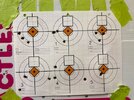Torn between starting a new thread, or tacking on here.......and concluded it may further OP's agenda more if offered here.
First, in terms of my shooting ability, I place myself no higher than average. Pretty much typical of average guy trying to develop reasonably accurate ammunition for hunting purposes. For my purposes and used in my conditions, ammo that will shoot 1 MOA at factory ammo velocity is perfectly adequate for the job at hand, so that is my goal.
So you read, study and then go to work putting theory into practice. And this is what happened to me........
First up is a target that shows results of a 10 shot incremental ladder. Wasn't shooting for accuracy at all. Was focused on results over the chronograph. Didn't find a distinct plateau, and at first glance, didn't like the group I found, and really didn't like the signs of pressure I was seeing, nor the nasty recoil that was building, so this powder was quickly abandoned as a failure. Or was it? The three fliers aside, that was a 1 MOA group. Were those the loads or me? I don't know cause I wasn't paying attention.
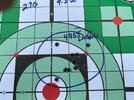
Next group.......same rifle.......still didn't like the group. At least then. But now consider this group was shot late in the PM, dusk setting in. Target was 125 yards away, honking 20 mph crosswind blowing left to right, and me shooting from an awkward stance off a big round hay bale. And I pulled the shot that landed far right. That was on me.
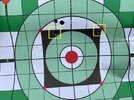
Last group for this rifle........the load I settled on.......also shot by me off the bench under good conditions. Seems so much better than the others, but is it really? Case could be made that rifle did well with all three loads and any one of them would have met my objective.
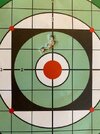
Next up is a group shot with a new to me rifle. This was the last 5 rounds of a box of hastily put together rounds to be used to sight in the rifle, plus fire form the brass so I could commence load development. At first glance, not happy with what was printed on paper, but then know that the flier to the right was on me. I can recall where the scope was pointed at when the rifle fired. Move that to the left to where it was supposed to be and my load development is done. That target won't win any prizes, but the rifle is shooting fine.
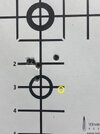
And then there is this target. This was as good as it got no matter what I did. Hundreds of rounds.......and lots done to the rifle, and still no joy. Last thing I did was scrub the barrel clean, the took it to a smith who scoped the bore. What we found was deep corrosion pitting coast to coast. Years of neglect and abuse had taken it's toll. Choices are live with it..........adjust scope to move impacts up and right to cluster around the square and the rifle can still kill a lot deer inside 200 yards........or put on a new barrel to tighten that up by half.
But when examined critically, even if shot exactly as shown, deer was going down. Sometimes you have to put things into perspective.
Edit: Just realized I never made my point......which was when examining groups, do so with a critical eye. The actual groups don't say it all. For hunting ammo in sporting rifles, we are not loading or shooting for scores, but for results. If doing load development and I pull a shot, and it appears as a flier, as long as I know I was at fault, I ignore it. That is on me. Not the fault of gun or load.
